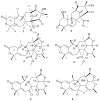The berkeleyacetals, three meroterpenes from a deep water acid mine waste Penicillium
- PMID: 17970594
- PMCID: PMC2562172
- DOI: 10.1021/np070329z
The berkeleyacetals, three meroterpenes from a deep water acid mine waste Penicillium
Abstract
Berkeley Pit Lake is a 1500 ft deep abandoned open-pit copper mine filled with over 1140 billion liters of acidic, metal-sulfate-contaminated water. This harsh environment is proving to be a source of unusual microorganisms that produce novel bioactive compounds. We recently reported the structures of berkeleydione (1) and berkeleytrione (2), two novel hybrid polyketide-terpenoid metabolites isolated from a deep water Penicillium sp. growing in Berkeley Pit Lake. In this paper we report the structures of three new compounds, berkeleyacetals A-C ( 3-5) isolated from extracts of this fungus. The structures of these compounds were deduced by comparison of mass spectral and NMR data to that of berkeleydione (1).
Figures
References
-
- Montana Bureau of Mines and Geology. Berkeley Pit and Butte Mine-Flooding Operable Unit. [January 10, 2006]. website: http://www.mbmg.mtech.edu/env-berkeley.htm.
-
- Stierle AA, Stierle DB, Parker K, Goldstein E, Bugni T, Baarson C, Gress J, Blake D. J Nat Prod. 2003;66:1097–1100. - PubMed
-
- Stierle DB, Stierle AA, Hobbs JD, Stokken J, Clardy J. Org Lett. 2004;6:1049–1052. - PubMed
-
- Stierle AA, Stierle DB, Kelly K. J Org Chem. 2006;71:5357–5360. - PubMed
-
- Stierle AA, Stierle DB, Kemp K. J Nat Prod. 2004;67:1392–1395. - PubMed
Publication types
MeSH terms
Substances
Grants and funding
LinkOut - more resources
Full Text Sources




